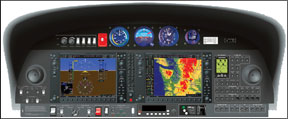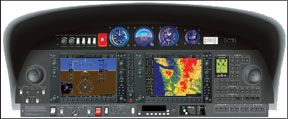It happens all the time. We invest in all this fancy hardware and top it off with that new autopilot that does everything for us except close the flightplan. We like using that stuff because its easy, precise and, well, kind of cool. However, reliance on the automation can go too far and actually cause the very trouble were trying to avoid. A good coupled autopilot is a wonderful thing. It frees us from much of the mind-numbing concentration of keeping the airplane right side up to allow us to focus on 288 bigger things like setting up for the approach or even just relaxing a bit at cruise. Add a GPS and you can program everything but your initial departure vectors and the vectors to final. The airplane can fly your entire flight plan while you pay attention to more important things like fuel management or the weather. Or not, and thats one of the problems. Whats It Doing 
When your head is in the game concentrating on flying the airplane youve learned to gather up the whole big picture. In addition to concentrating on straight and level, youre thinking about the entire flight and actively managing it. You might even go so far as to keep a flight log to measure your actual vs. predicted progress and fuel burn. When the airplane is flying itself our minds wander with nothing to do, or we tend to be more social with our passengers and generally just assume that everything is progressing properly. Sometimes its not.
Aviation accident reports are rife with examples like the guy who fell asleep and plowed into a mountain, or the fellow who was apologizing to his passengers that they werent making the groundspeed hed expected until he simply ran out of gas at cruise. We know of one night freight dog who used to just set up everything for cruise, then dial in the AWOS for his destination on #2 with the volume up. Being tired from not getting enough sleep during the day he would then engage the autopilot, push the seat back and deliberately go to sleep. He relied on the AWOS to wake him up when he was in range in about an hour, until that night when he didnt know the AWOS was out of service. Oops.
The lesson of this one is simple: Pay attention. Sure, let George handle the tedious stuff, but dont forget to take care of all those other Pilot-In-Command things like fuel and engine management, watching the weather, scanning for traffic, etc. Consider using a flight progress log with the waypoints showing time and fuel for each leg. You remember those; you used them when you were learning to fly and probably again when you did your instrument training. Maybe take some engine readings to compare the various parameters under the varying conditions. Youd be amazed how this can help you track down trouble in the future. We know an IFR pilot who still tracks his progress on VFR charts as he chugs along on his flights. He says it helps him with situational awareness, he always knows where there is a suitable emergency field and he simply enjoys watching the scenery go by. However you choose to do it, dont disengage from the flight when you engage the autopilot.
Beyond the autopilot, be sure to actively monitor your GPS, too. Its sadly all too common to be given a clearance change, for instance and to program it in to the GPS only to find- later- that you didnt do it correctly. Ever ask yourself, “Whats it doing
now?” or, “Wheres it going?” Sure you have! Hint: It is doing exactly what you told it to; its going exactly where you told it to.We recall reading an incident report of a guy out of Salt Lake City who was given direct to a fix that was near his destination but not on his flight plan. He plugged it into his GPS flight plan and off he went, happily through the soup. A couple minutes later he got that dreaded call from Center, “Where are you going?” “Direct,” he replied to which they pointed out that he was about 120 degrees off course. Hed misspelled the name of the fix and was headed right toward a mountain where, if hed had a radar altimeter it would have soon read zero.
Monitor The Magic
So, lets assume that youve remained engaged in the flight and actively monitored and managed your progress. Youve now reached your destination and the weather is right down to minimums with a gusty crosswind. If ever there was a time for an autopilot, this is it, right? Well, yes and no.
We agree that using a capable coupled autopilot on a difficult approach is much less stressful and does allow us the brain cycles to concentrate on actually monitoring the big picture instead of just trying to keep the needles centered. However, theres a big caveat here: how well will your autopilot do under these circumstances? Even the most sophisticated systems in the biggest planes can get behind a strong crosswind on an intercept and blast through final. Your system probably isnt nearly as capable; how will it do on that intercept? (Or will it even do an intercept? Many wont and rely on you to do it, after which itll happily fly the straight-in approach.) How will it do trying to sort out the crosswind to keep the localizer centered? Watch. Be quick to correct any bad trends before they become problems. Most of the common GA autopilots can do a fine job on a coupled approach in good conditions, but some start to wander in any kind of instability.
Also, dont forget that George relies on you to properly configure the airplane. Even if your autopilot does a wonderful job on a difficult approach, a configuration change once its captured the glideslope, for instance, might send it off into a fit trying to find the new pitch equilibrium, and it might never catch up with the glideslope thats demanding more and more precision as you get lower.
The point is that if you turn over the responsibility of flying the approach to George, make sure he does what you want. Again, dont disengage from the process when you engage the autopilot. Instead, pretend youre an instructor and George is a student. Watch him closely and be sure to quickly “point out” any developing problems.
Dependence
Weve looked at two types of automation complacency: Not paying attention to the rest of your flight, and not monitoring a critical phase for proper performance of your autopilot. Theres one more that we see all the time, and thats over-reliance on the autopilot. Sometimes its simply easier and better to just hand fly the airplane.
Youre flying your new high performance airplane that cruises along at over 200 knots. Youre nearing your destination-a busy regional airport with an approach control and plenty of weekend flyers out trying to stay current. Of course, ATC is saturated trying to manage all the traffic with the different approach requests and all the missed approaches. You come along and all you want to do is land.
As you get handed off from center to approach, youre assigned lower, a heading for vectors to final and a speed reduction from the downhill ride youve been enjoying. You grumble at the speed reduction thinking you didnt spend all the money on this hot rod only to have ATC lower the speed limit. Then you realize youre going to be merging into the system with a few IFR trainers wholl be operating much slower and you get serious about slowing down. You punch heading mode on the autopilot, enter the heading, dial in the new assigned altitude, pitch the plane over into a descent and pull back the throttle. However, youre in a descent and youre just not slowing enough. You dont want to pull the throttle back any further because of your concern for shock cooling. So, you dial a reduced pitch angle on the autopilot hoping thatll be enough. Then ATC repeats the new altitude and speed because, to them, youve not made much of a change. After another minute with this plan clearly not working, ATC gives you another vector, a further speed reduction and another altitude, all trying to keep you from chewing up the Skyhawk in front of you. Getting busy?
There comes a time in every flight where youve simply got to turn off the autopilot. If youre in a big enough bird the traffic may part for you and with autoland, that time is on the landing roll. For most of the rest of us, that time is right about now in our example. Things are getting busy enough where its actually easier to just tell George to take a break and for you to take over the flying manually. For example, if youre hand flying, its instinctive to slow down in this situation-youll just maintain altitude for a moment with the power back, then re-trim for the lower speed and let the descent begin. You intuitively know this, but the autopilot doesnt. Its just a computer trying to do everything youve told it, and somehow you felt compelled to program it with all the instructions ATC gave you.
Whats In Your Toolbox?
Theres one overarching lesson in all this: All our fancy automation is just a set of tools and weve got to know when to use them, what to use and when to just do things by hand. You wouldnt use a hammer to tighten a screw (well, you
shouldnt) any more than youd use a power screwdriver to set a nail. Use your tools properly, and at the right time without becoming too reliant on them and you will have achieved harmony and balance in your life. (Well, in your flying.)



